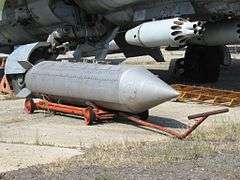KMGU
KMGU (Russian: Контейнер малогабаритных грузов унифицированный, Unified Container for Small-sized Load) is a Soviet munitions dispenser similar to the British JP233 and the German MW-1. It can be carried by most Soviet and Russian attack aircraft, including the MiG-23, the MiG-27, the MiG-29, the Su-22, the Su-24, the Su-25, the Su-27, the Su-30, and the Su-34 and the Mi-24, Ka-50 and the Ka-52 attack helicopter. The cylindrical aluminum fuselage is divided into 8 sections, each has its own pneumatically opened doors. It can be filled with:
- 96 (8×12) AO-2,5RT 2.5 kilogram-mass high explosive mines
- 96 (8×12) PTM-1 anti-tank mines
- 156 PFM-1S mines
| KMGU | |
|---|---|
 KMGU container under a Czech Air Force MiG-23 | |
| Type | Submunition delivery system |
| Place of origin | Soviet Union |
| Service history | |
| Used by | Soviet Air Force |
| Wars | Soviet–Afghan War |
| Specifications | |
| Filling | 96 (8×12) AO–2,5RT 2,5 kilogram-mass high explosive mines 96 (8×12) PTM–1 anti-tank mines 156 PFM–1S mines |
KMGU-2 is an advanced version of the system. Convention on Certain Conventional Weapons restricts usage of such weapon systems.
Users
gollark: ***weird odditude***
gollark: The mystery grows ever more mysterious with each gügling.
gollark: I'm fairly sure BT is quite bad as well for this sort of thing.
gollark: Mysterious...
gollark: Now THAT'S security!
External sources
- КМГУ at the Sky Corner site
- KMG-U – janes.com
This article is issued from Wikipedia. The text is licensed under Creative Commons - Attribution - Sharealike. Additional terms may apply for the media files.